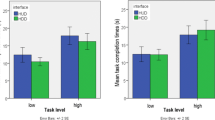Abstract
The use of a head-up-display has been extensively researched in the context of two track vehicles, human system interaction and improved road safety. The aim of this study is to measure workload and response time for a secondary task while riding a powered-two-wheeler. For this purpose, a head mounted smart glasses device was used to provide driving information. A secondary task was implemented for comparison with a conventional digital information display in the motorcycle segment. The focus was to determine the “response time”, “response rate”, “mental workload”, “obtrusiveness” and “usefulness” for both displays. During the 15-min ride, the secondary task consisted of confirming the perception of a direction change in the navigation arrows. The mental workload was measured using the rider-activity-load-index questionnaire and compared between both displays. The results show a lower workload using the head-up-display and a faster response time and frequency fulfilling the secondary task. Usefulness depends on the shown information, which should be further investigated.
Access this chapter
Tax calculation will be finalised at checkout
Purchases are for personal use only
Similar content being viewed by others
References
Pauzie, A.: Head up display in automotive: a new reality for the driver. In: Marcus, A. (ed.) DUXU 2015. LNCS, vol. 9188, pp. 505–516. Springer, Cham (2015). https://doi.org/10.1007/978-3-319-20889-3_47
Kim, H., Wu, X., Gabbard, J.L., Polys, N.F.: Exploring head-up augmented reality interfaces for crash warning systems. In: User Interfaces and Interactive Vehicular Applications-Automotive UI 2013, pp. 224–227 (2013)
Hibberd, D.L., Jamson, S.L., Carsten, O.M.J.: Managing in-vehicle distraction: evidence from the psychological refractory period paradigm. In: International Conference on Automotive UI, pp. 4–11 (2010)
Grahn, H., Kujala, T.: Visual distraction effects between in-vehicle tasks with a smartphone and a motorcycle helmet-mounted head-up display. In: Proceedings of the 22nd International Academic Mindtrek Conference, pp. 153–162 (2018)
Ito, K., Nishimura, H., Ogi, T.: Head-up display for motorcycle navigation. In: SIGGRAPH Asia 2015 Head-Up Displays and their Applications, pp. 1–3 (2015)
Ito, K., Nishimura, H., Ogi, T.: Motorcycle head-up display: design of presenting navigation information. IEEE Consum. Electron. Mag. 8(5), 74–78 (2019)
Vaya, P., Simon, R., Khatri, S.K.: Motorcycle safety solution using the internet of things. In: 2019 4th International Conference on Information Systems and Computer Networks (ISCON), pp. 95–98 (2019)
Guth, S.: Absicherungsmethode von Anzeigekonzepten zur Darstellung fahrfremder Informationen mittels eines Motorrad-Fahrsimulators (2017)
Pauzié, A.: Evaluation of the driver’s mental workload: a necessity in a perspective of in-vehicle system design for road safety improvement. Cogn. Technol. Work 16(3), 299–302 (2014)
Colligan, L., Potts, H.W., Finn, C.T., Sinkin, R.A.: Cognitive workload changes for nurses transitioning from a legacy system with paper documentation to a commercial electronic health record. Int. J. Med. Inform. 84(7), 469–476 (2015)
Pauzié, A.: A method to assess the driver mental workload: the driving activity load index (DALI). IET Intel. Transp. Syst. 2(4), 315–322 (2008)
Cao, Y., Mahr, A., Castronovo, S., Theune, M., Stahl, C., Müller, C.A.: Local danger warnings for drivers: the effect of modality and level of assistance on driver reaction. In: Proceedings of the 15th International Conference on Intelligent User Interfaces, pp. 239–248 (2010)
McKnight, A.J., McKnight, A.S.: The effects of motorcycle helmets upon seeing and hearing. Accid. Anal. Prev. 27(4), 493–501 (1995)
Gordon, S., Prince, J.: Field of view with and without motorcycle helmets No. DOT-HS-801–758 Final Rpt. (1975)
Strobl, M.H.: Spider-das innovative software-framework der BMW fahrsimulation/spider-the innovative software framework of the BMW driving simulation. VDI-Berichte, Version 1745 (2003)
Parduzi, A., Venrooij, J., Marker, S.: A method to assess the effect of vertical dynamics on driving performance in driving simulators: a behavioural validation study. In: Krömker, H. (ed.) HCI in Mobility, Transport, and Automotive Systems. LNCS, vol. 11596, pp. 176–189. Springer, Cham (2019). https://doi.org/10.1007/978-3-030-22666-4_13
Naujoks, F.: Frühzeitige Fahrerinformationen zur Konfliktvermeidung bei urbanen Verkehrskonflikten-Gestaltung und Absicherung (2015)
Böhm, M., Fuchs, S., Pfliegl, R., Kölbl, R.: Driver behavior and user acceptance of cooperative systems based on infrastructure-to-vehicle communication. Transp. Res. Rec. 2129(1), 136–144 (2009)
Morice, A.H., Sevrez, V., Gray, R., Montagne, G.: Investigating the interaction between helmet field of view and steering behavior in a novel motorcycle simulator (2015)
Field, A.: Discovering Statistics Using IBM SPSS Statistics. Sage, Sussex (2013)
Acknowledgments
As first author, Arthur Werle initiated the research, conducted the literature review, planned the user studies and conducted the qualitative user study. His contribution was 90 %. Ivana Cujic requested this pre-study. Frank Diermeyer revised the content of this work critically and made an essential contribution to the conception of the research project. Frank Diermeyer gave final approval of the version to be published and agrees to all aspects of the work. As a guarantor, he accepts responsibility for the overall integrity of the paper. This research was funded by BMW Motorrad.
Author information
Authors and Affiliations
Corresponding author
Editor information
Editors and Affiliations
Rights and permissions
Copyright information
© 2021 The Author(s), under exclusive license to Springer Nature Switzerland AG
About this paper
Cite this paper
Werle, A., Diermeyer, F. (2021). An Investigation of Smart Glasses for Motorcyclists as a Head-Up-Display Device - Performed on a Riding Simulator. In: Stanton, N. (eds) Advances in Human Aspects of Transportation. AHFE 2021. Lecture Notes in Networks and Systems, vol 270. Springer, Cham. https://doi.org/10.1007/978-3-030-80012-3_28
Download citation
DOI: https://doi.org/10.1007/978-3-030-80012-3_28
Published:
Publisher Name: Springer, Cham
Print ISBN: 978-3-030-80011-6
Online ISBN: 978-3-030-80012-3
eBook Packages: EngineeringEngineering (R0)




